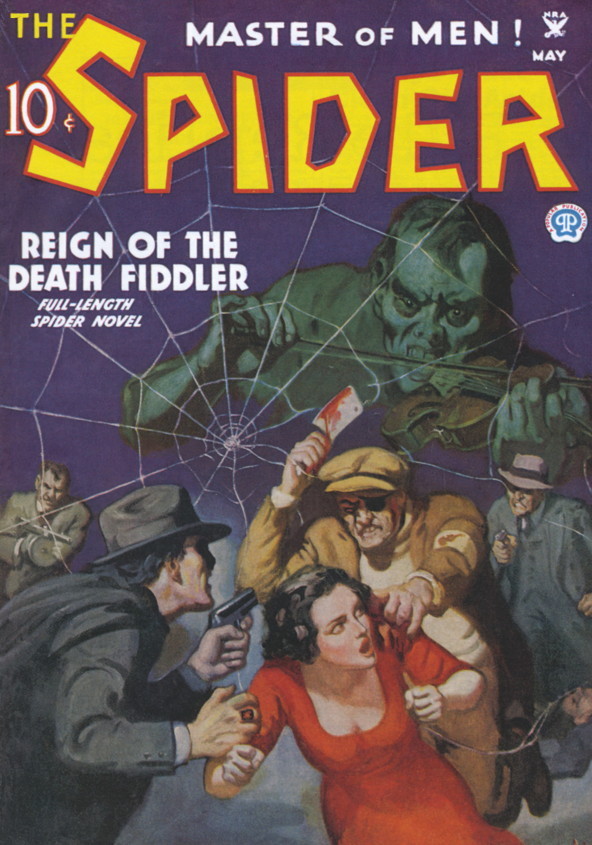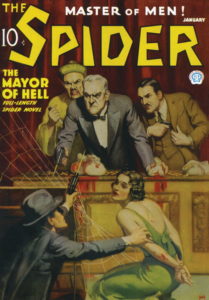
“The Mayor of Hell” was originally published in the January 1936 issue of The Spider Magazine. Combined forces of the Mayor of Hell — the crooked Law and the vengeful Underworld — besiege Richard Wentworth, otherwise known as The Spider, nemesis of criminals! Mourned as dead, The Spider must start life anew, without friends or funds or hidden refuge, so that the Mayor of Hell’s bloody-handed henchmen may find their just reward — in death!
This is a respectable Spider outing, but it lacks the “wow” factor that makes The Spider tales so iconic. There are no living mummies… no dissolving humans… no plague of spiders and snakes. It’s just a straightforward story of The Spider battling against one master criminal who called himself “The Mayor of Hell.” As usual, The Spider can trust no one except for his close-knit group of assistants. Everyone is suspect, the Mayor of New York, the governor, the legislature, and, of course, the entire police force. Everyone is corrupt. And maybe that is the “wow” factor in place for this story. If so, it’s not really enough to make it a great story. It ends up being fun to read, but not compelling.
Wentworth at the violin
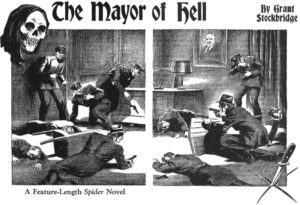
When the story opens, Richard Wentworth is playing the violin in his penthouse apartment (he owns the entire 15-story building, by the way). Through the French doors smash two gunmen with sub-machine guns blazing. By the time Ram Singh, Jackson and Jenkyns rush to his aid, it’s all over. Wentworth has wiped up the two thugs.
A machine gun opens up from a building from across the street; an airplane dives, shooting orange flame from its twin machine guns. It drops bombs upon Wentworth’s apartment building. In the midst of the attack, Daniel Fogerty, Deputy Commissioner of Police, comes up the elevator and announces he has a warrant for Wentworth’s arrest. He’s being charged with murder… many murders… he’s being charged with being The Spider! And where is Commissioner Flynn? He’s dead. Killed by a bomb from an airplane.
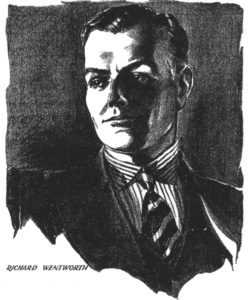
All this is happening in the midst of battle while Ram Singh fires back at the machine gun across the way. Fogerty urges his men attack, and falsely claims Wentworth is resisting. Obviously, Fogerty has thrown in with criminals. Are the forces of the law allied with the Underworld? Paranoia continues to run high.
Wentworth captures one of the assailants and forces him to name his chief. It’s the Mayor! Not the Mayor of New York City, but a master criminal who calls himself The Mayor of Hell.
As usual, the action if frenetic. The threesome, Wentworth, Jackson and Ram Singh try to escape and are separated. Jackson is shot and wounded; he and Ram Singh are captured by the police and thrown in prison for aiding and abetting a criminal. Wentworth exchanges clothes with a dead man and makes good his escape as well, but is injured.
Wentworth, the punching bag

When The Spider gets wounded, he always takes a real beating. Rarely does he receive just one bullet. Oh no! He’s shot in the left shoulder; another bullet strikes his ribs low down in back; he crawls through a broken window — the jagged glass slices through his flesh; another slug hits him somewhere in the back, making his whole body numb. He’s dying… frustrated, he fires back. A bullet hits his arm, striking the gun from his hand. And the wounds just keep on coming. His face is badly disfigured by shrapnel… so badly that in the rest of the story he doesn’t need a disguise. He’s unrecognizable!
Wentworth is saved by a stranger, one Patrick O’Rourke, and his daughter Kathleen. He sleeps, and it takes six weeks of recuperation before he is aware of what is going on. A lot has taken place during that time. The mysterious Mayor of Hell has seemingly taken over. One of the state senators has been killed in an accident arranged by the Mayor of Hell, and the senator’s replacement, Hoey, is in the pay of the mastermind. He’s siphoning millions from the state under the guise of a “special relief” fund. Hoey has trumped up charges against Wentworth’s friend Gov. Stanley Kirkpatrick and had him impeached and thrown out of office. And Richard Wentworth, who the newspapers proclaim fought for humanity under the name of The Spider, is assumed dead.
Wentworth, since he’s assumed dead, has had all his wealth confiscated by the state under a new law passed by Sen. Hoey. Gov. Stanley Kirkpatrick, the former Police Commissioner and good friend of Richard Wentworth, has been framed and thrown out of office. The new state chief, Gov. Langson, is a puppet of Sen. Hoey and the Mayor of Hell. Wentworth’s friends, Jackson, Ram Singh, Jenkyns, and Nita van Sloan, his sweetheart, are mourning his death, but for their own safety, he can’t notify them that he’s still alive. That means he’s lone and penniless. And somehow, he must battle on. But wait… it gets worse! (Doesn’t it always?)
Crooks have been hired on the police force, and they now run the city. The newspapers have been taken over, and only print what the Mayor of Hell wants them to see. Nita, the love of Wentworth’s life, has been seriously wounded and lies between life and death for weeks. Wentworth’s cronies are in jail. There’s no one to whom he can turn!
As is the case in all of The Spider novels, the odds are stacked against The Spider, Richard Wentworth. In this case, they are so heavily stacked that it makes one wonder how he can overcome the odds. But Wentworth uses his facial disfiguration to his advantage. No one will recognize him as Richard Wentworth, so he can move about in the open and become a new person. So he becomes a new champion of justice known as Colonel Death. Talk about turning lemons into lemonade!
Colonel Death
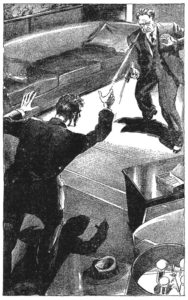
It’s as Colonel Death that Wentworth sets out to take on the corrupt political machine of the city and of the state. It’s as Colonel Death that he terrorizes the Underworld with his brutal killings of the thugs that run the town. So this isn’t exactly a Spider story, anymore. It’s a Colonel Death story.
The familiar characters only make brief appearances in this story, save for Stanley Kirkpatrick. We see Nita van Sloan briefly before her gunshot injury puts her in a medical ward. We see Jackson and Ram Singh only in the first two chapters as they battle alongside Wentworth. But once they are caught and imprisoned, we see no more of them. But late in the story, Stanley Kirkpatrick shows up to work with Colonel Death.
Of course, you know all will work out in the end. And it does. By the last page, Stanley Kirkpatrick is back running the Police Department, and the Mayor of Hell has been soundly defeated. But there are still unresolved plot points. And that’s where next month’s issue of The Spider magazine comes in. Things will be resolved then, in the second part of the tale. And in that issue, there is definitely more of a “wow” appeal, with the weird Dance of Death and the human Dissolver salts. But that’s next month. In this story, Nita is still recuperating, Jackson and Ram Singh are still in jail, and Wentworth must clear himself of Deputy Commissioner Fogerty’s charges and regain his confiscated fortune.
Master of Disguise… or maybe not…
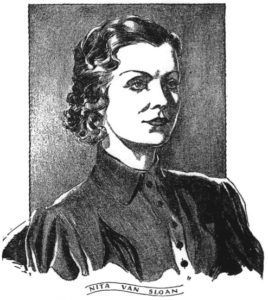
The Spider is master of disguise, but in this story, he needs none. Since his face is disfigured, he just goes about openly. It one scene, he does disguise himself as an itinerant violin player on a street corner, but there is no facial makeup involved.
Readers are told a few interesting bits of The Spider’s backstory. It seems that Nita van Sloan wasn’t with him at the beginning of his career against crime. “When he had met Nita, his life was already pledged to the service of humanity, The Spider had been a scourge of the Underworld for three full years.” And Doctor Higgins, the medico to whom he takes Nita when she is shot, has a history with Wentworth. We aren’t given the details, but simply told that “Wentworth had done him a service once that Higgins could never forget.”
The only loose end that I noticed in this story is that apparently Wentworth’s face is still scarred and unrecognizable at the story’s end. Yet in the second part of the tale, which takes up in the following month’s magazine issue, nothing is said of his face and everyone recognizes him. Maybe he healed suddenly? Or maybe he used makeup to look like his old self? A little plastic surgery? Readers aren’t told.
This is a fun story with the usual non-stop action. I guess not every Spider story could have some weird little twist, but the fact that this story lacks one makes it enjoyable but not very special. Maybe author Norvell Page was saving that for part two. This story, by itself, is only average. But paired with the following month’s tale, it rates higher. Yes, things get better…

